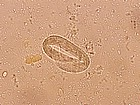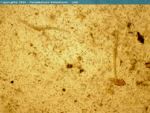Difference between revisions of "Strongyloidea"
Jump to navigation
Jump to search
(Redirected page to Category:Strongyloidea) |
m |
||
| (6 intermediate revisions by 4 users not shown) | |||
| Line 1: | Line 1: | ||
| − | + | {{unfinished}} | |
| + | |||
| + | {{toplink | ||
| + | |backcolour = | ||
| + | |linkpage =Parasites | ||
| + | |linktext =PARASITES | ||
| + | |pagetype=Bugs | ||
| + | |sublink1=Nematodes | ||
| + | |subtext1=NEMATODES | ||
| + | }} | ||
| + | <br> | ||
| + | |||
| + | == General Appearance == | ||
| + | [[Image:Strongyloides stercoralis.jpg|thumb|right|150px|''Strongyloides stercoralis'' - Joaquim Castellà Veterinary Parasitology Universitat Autònoma de Barcelona]] | ||
| + | [[Image:Strongyloides larvae.jpg|thumb|right|150px|''Strongyloides'' larvae - Joaquim Castellà Veterinary Parasitology Universitat Autònoma de Barcelona]] | ||
| + | *Bursate. | ||
| + | *Relatively short (typically 1-5cm) but stout. | ||
| + | *Heads often have characteristic features. | ||
| + | |||
| + | |||
| + | == General Life-Cycle == | ||
| + | Like that of the trichostrongyloids (eggs are also 'typical strongyle eggs'), but: | ||
| + | *L3 → L4 → adult (typically occurs in the large intestine). | ||
| + | *Larvae penetrate into mucosal wall and elicit nodule formation. | ||
| + | *Larvae of some species migrate around the body. | ||
| + | *Prepatent period varies between species from 3weeks to 6+ months. | ||
| + | |||
| + | |||
| + | |||
| + | |||
| + | |||
| + | |||
| + | |||
| + | [[Strongylus vulgaris]] | ||
| + | |||
| + | [[Peritoneal Cavity Inflammatory - Pathology#In sheep|Peritonitis in sheep]] by penetration of intestines by larvae of ''Oesophagostomum columbianum'' | ||
| + | |||
| + | ''Strongylus edentatus'' and ''Strongylus equinus'' migrate through [[Peritoneal Cavity Parasitic - Pathology]] | ||
| + | |||
| + | ''Stephanuris dentatus'' causes peritonitis in pigs [[Peritoneal Cavity Parasitic - Pathology]] and may cause cysts in the [[Pancreas Parasitic - Pathology|pancreas]] | ||
| + | |||
| + | ''Syngamus laryngeus'' in [[Respiratory Parasitic Infections - Pathology#Syngamus laryngeus|larynx]] of cattle | ||
Revision as of 14:08, 23 December 2008
| This article is still under construction. |
|
|
General Appearance
- Bursate.
- Relatively short (typically 1-5cm) but stout.
- Heads often have characteristic features.
General Life-Cycle
Like that of the trichostrongyloids (eggs are also 'typical strongyle eggs'), but:
- L3 → L4 → adult (typically occurs in the large intestine).
- Larvae penetrate into mucosal wall and elicit nodule formation.
- Larvae of some species migrate around the body.
- Prepatent period varies between species from 3weeks to 6+ months.
Peritonitis in sheep by penetration of intestines by larvae of Oesophagostomum columbianum
Strongylus edentatus and Strongylus equinus migrate through Peritoneal Cavity Parasitic - Pathology
Stephanuris dentatus causes peritonitis in pigs Peritoneal Cavity Parasitic - Pathology and may cause cysts in the pancreas
Syngamus laryngeus in larynx of cattle

